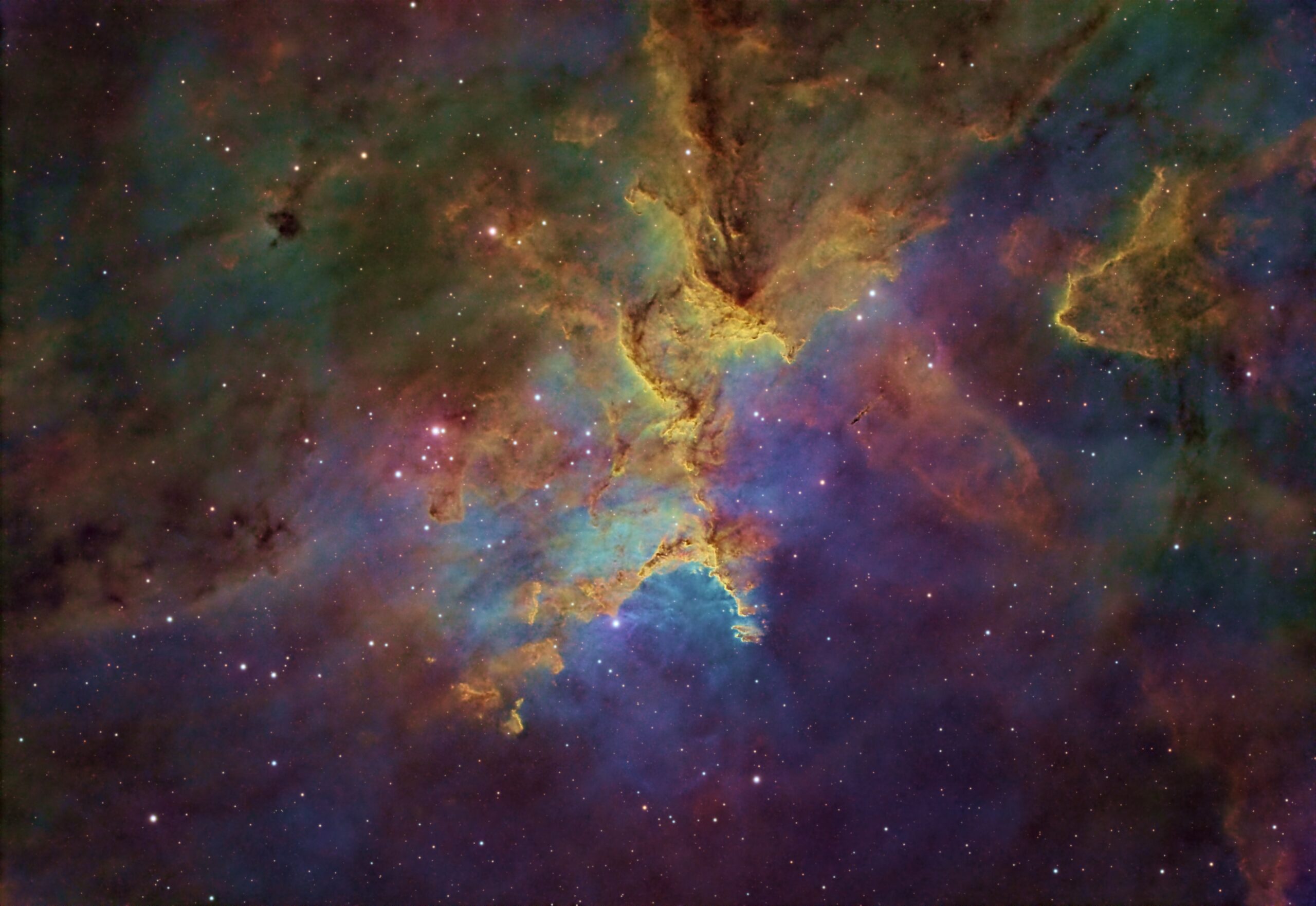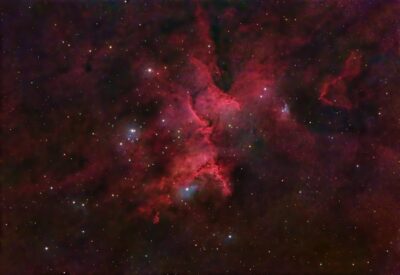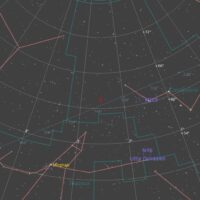IC 1805 – Heart of the Heart Nebula
 Click image for full size version
Click image for full size version
November 18, 2024
 IC 1805 is also called The Heart Nebula, and is a large complex cloud of glowing gas in Cassiopeia. It is also catalogued as Sh2-190. This image shows the ‘Heart of the Heart,’ which you can see in context in wider-field images here and here. This object is about 7,500 light years away and is located in the Perseus arm of the Milky Way Galaxy. The image above used narrowband sulfur, hydrogen and oxygen emissions to make a false color palette, with the stars coming from broadband red, green, and blue filters. I blended two narrowband palettes (Hubble and Foraxx) to create the wide range of hues. I also made a natural-colour image from the RGB data, supplemented with H-alpha, shown at right.
IC 1805 is also called The Heart Nebula, and is a large complex cloud of glowing gas in Cassiopeia. It is also catalogued as Sh2-190. This image shows the ‘Heart of the Heart,’ which you can see in context in wider-field images here and here. This object is about 7,500 light years away and is located in the Perseus arm of the Milky Way Galaxy. The image above used narrowband sulfur, hydrogen and oxygen emissions to make a false color palette, with the stars coming from broadband red, green, and blue filters. I blended two narrowband palettes (Hubble and Foraxx) to create the wide range of hues. I also made a natural-colour image from the RGB data, supplemented with H-alpha, shown at right.
Tekkies:
Acquisition, focusing, and control of Paramount MX mount with N.I.N.A., TheSkyX. Guiding with PHD2. Primalucelab low-profile 2″ Essato focuser, ARCO rotator and Giotto flat panel. Equipment control with PrimaLuce Labs Eagle 4 Pro computer. All pre-processing and processing in PixInsight. Acquired from my SkyShed in Guelph. Above average transparency and average or better seeing. SHO data acquired during and after full moon, and RGB data acquired in a moonless sky, all between October 16-21, 2024.
Celestron 14″ EDGE HD telescope at f/11 (3,931 mm focal length) and QHY600M-SBFL camera binned 2×2 with Optolong filters.
13x5m Red = 1hr05m
19x5m Green = 1hr35m
18x5m Blue = 1hr00m
99x5m S2 = 8hr15m
102x5m Ha = 8hr30m
104x5m O3 = 8hr40m
Total: 27hr05m
Preprocessing: The WeightedBatchPreProcessing script was used to perform calibration, cosmetic correction, weighting, registration, local normalization, integration, and auto-cropping.
Colour master: A colour master was made from the Red, Green and Blue masters using ChannelCombination in RGB mode.
Gradient Removal: DynamicBackgroundExtraction was applied to the RGB and narrowband masters.
Colour Calibration: ColorCalibration was used to calibrate the RGB master.
Deconvolution: BlurXterminator was used on the RGB and narrowband masters with Automatic psf at default settings.
Linear Noise Reduction: NoiseXterminator was applied to the RGB and narrowband masters with settings Amount=0.9 and Detail=0.35
Star Removal: StarXterminator was used to remove the stars from each of the RGB and narrowband masters, with default settings. Only the RGB stars-only image was preserved.
Hubble Palette Image Creation: The H and O masters were balanced to S using LinearFit and combined using ChannelCombination in RGB mode.
Stretching: HistogramTransformation was applied to the RGB, SHO and narrowband masters to make pleasing images. Approximate background level after the stretches was 0.10 for RGB and SHO and 0.09 for the individual narrowband masters.
Nonlinear Processing
Foraxx Palette Image Creation: The stretched S, H and O masters were combined with Paul Hancock’s Foraxx Palette Utility script.
Background Cleanup: Artifacts that were visible in the three master images were removed using the CloneStamp tool.
Nonlinear Noise Reduction: NoiseXterminator was used to reduce noise in the background areas of the RGB, Hubble and Forrax palette masters with settings Amount=0.9 and Detail=0.15. This was followed with TGVDenoise in L*a*b* mode with default settings except iterations was increased to 1000. A mask was used so that TGVDenoise was applied only to the darkest parts of the image.
Dynamic Range Compression: The CreateHDRImage script was used to compress the core of the nebula using a mask made with the RangeSelection tool. This was applied to all three images.
Contrast Enhancement: LocalHistogramEqualization was applied twice to each image. A Contrast Limit of 1.5 and 1 iteration was used for each LHE application (scale 150, strength 0.25; scale 50, strength 0.22).
Brightness Enhancement: Using a mask to protect the background and bright parts of the nebula, the faint parts of the nebula were brightened in each master image with ExponentialTransformation and CurvesTransformation.
Sharpening: A mask was used to select brighter regions of nebulosity in each image for sharpening with MultiscaleMedianTransform (Layers 2 – 4 with strengths of 0.07, 0.07, and 0.03, respectively).
Hubble Palette and Foraxx Colour Adjustments: CurvesTransformation was used with Curves to adjust the colour tones in the two narrowband images.
Narrowband Image Blending: The Hubble and Foraxx palette masters were blended 80:20 using the Hubble image as the target image, and a mask that selected the brightest areas near the centre of the image.
Star Processing and Restoration: HistogramTransformation was used to stretch the stars-only RGB image, followed by CurvesTransformation through a star mask to boost saturation using the Saturation slider. The stars were added back into the master images using the Screen blending mode in PixelMath with the expression combine(starless, stars, op_screen()).
Final Steps: Background, nebula and star brightness, contrast, hue and saturation were adjusted using several iterations of CurvesTransformation, with masks, as required. ICCProfileTransformation (sRGB IEC61966-2.1; Relative Colorimetric with black point compensation) was applied prior to saving as a jpg. The finder chart was made using the FindingChart process.







Gorgeous. Interesting processing workflow. I’ll be studying it! Thanks Ron for,providing a workflow for us flunkies LOL
So nice Ron. 🙂